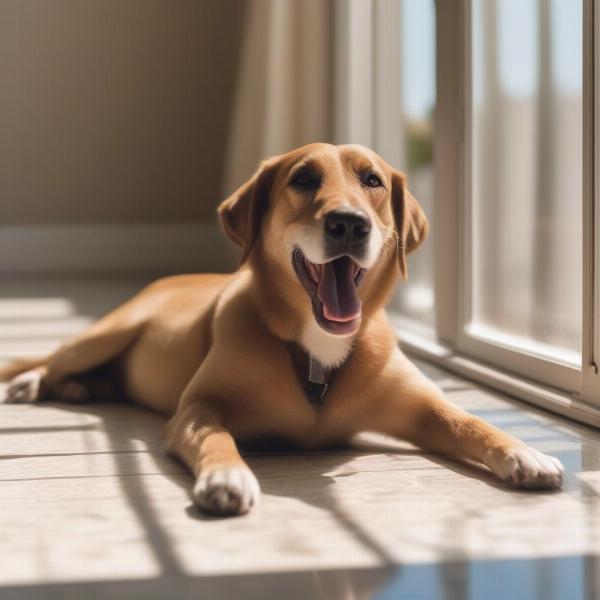A “cooler dog” isn’t just about looking cool – it’s about ensuring your furry friend stays comfortable and safe during warmer weather. From choosing the right cooling accessories to understanding the signs of heatstroke, this guide covers everything you need to know to keep your dog happy and healthy all summer long.
Understanding Your Dog’s Cooling Needs
Dogs don’t sweat like humans do. They primarily regulate their body temperature through panting and sweating through their paw pads. This makes them more susceptible to overheating, especially during hot and humid weather. Recognizing the signs of heatstroke, such as excessive panting, rapid breathing, weakness, and vomiting, is crucial for prompt intervention.
 Dog lying down in hot weather
Dog lying down in hot weather
Providing ample shade and fresh water is the first step in keeping your dog cool. Avoid exercising your dog during the hottest parts of the day and opt for walks in the early morning or late evening. If you must venture out during the day, consider walking your dog on grassy surfaces rather than hot pavement, which can burn their paws.
Choosing the Right Cooling Gear for Your Cooler Dog
There are numerous products designed to help keep your dog cool, ranging from cooling vests and mats to bandanas and even frozen treats. A cooler dog vest works by evaporative cooling, similar to how sweating cools humans. Simply soak the vest in water and put it on your dog. The evaporating water helps to lower their body temperature.
Cooling mats and dog bed cooler options provide a cool surface for your dog to lie on, helping to dissipate heat. These are especially beneficial for dogs who prefer to lounge indoors during hot weather. Frozen treats and toys can also provide a fun and refreshing way for your dog to cool down and stay entertained.
Creating a Cool Environment for Your Dog
Beyond cooling accessories, creating a cool environment at home is essential. Ensure your dog has access to a cool, shaded area, preferably indoors with air conditioning. Fans can also help circulate air and provide some relief, but be mindful of placing them directly on your dog, as this can be irritating or even dangerous.
If your dog enjoys swimming, supervised water play can be a great way for them to cool off. However, not all dogs are natural swimmers, so always introduce them to water gradually and never leave them unsupervised. For dogs who aren’t keen on swimming, a simple paddling pool or sprinkler can provide a fun and refreshing alternative.
Tips for a Cooler, Happier Dog
- Always provide fresh, cool water.
- Avoid exercising during the hottest parts of the day.
- Use cooling accessories like vests, mats, and bandanas.
- Create a cool, shaded area for your dog to rest.
- Supervise water play and never leave your dog unattended near water.
Conclusion
Keeping your cooler dog safe and comfortable during the summer months requires proactive measures and a little bit of planning. By understanding your dog’s cooling needs, choosing the right accessories, and creating a cool environment, you can ensure your furry friend enjoys a happy and healthy summer.
FAQ
- What are the signs of heatstroke in dogs? Excessive panting, rapid breathing, weakness, vomiting, and collapse are all signs of heatstroke.
- How can I tell if my dog is too hot? Look for excessive panting, drooling, and lethargy. Check their gums; if they are bright red or dark, it could indicate overheating.
- What’s the best way to cool down a dog quickly? Offer them cool water, move them to a shaded area, and apply cool (not cold) water to their paws and belly.
- Can I use ice packs to cool down my dog? Use caution with ice packs, as they can be too cold and cause discomfort or even frostbite. Wrap them in a towel before applying.
- How long does it take for a dog to recover from heatstroke? Recovery time varies depending on the severity of the heatstroke. Always seek veterinary attention immediately if you suspect your dog has heatstroke.
- Are there any breeds more susceptible to heatstroke? Brachycephalic breeds (those with short noses, like Bulldogs and Pugs) are more prone to heatstroke.
- What should I do if my dog shows signs of heatstroke? Immediately move your dog to a cool, shaded area, offer them cool water, and seek veterinary attention as quickly as possible.
ILM Dog is your trusted resource for expert advice on all aspects of dog care, from breed selection and health to training and nutrition. We offer a wide range of tweed dog bed and fashion sports dog jacket as well as other high-quality products to keep your companion happy and healthy. Contact us at [email protected] or +44 20-3965-8624 to learn more.